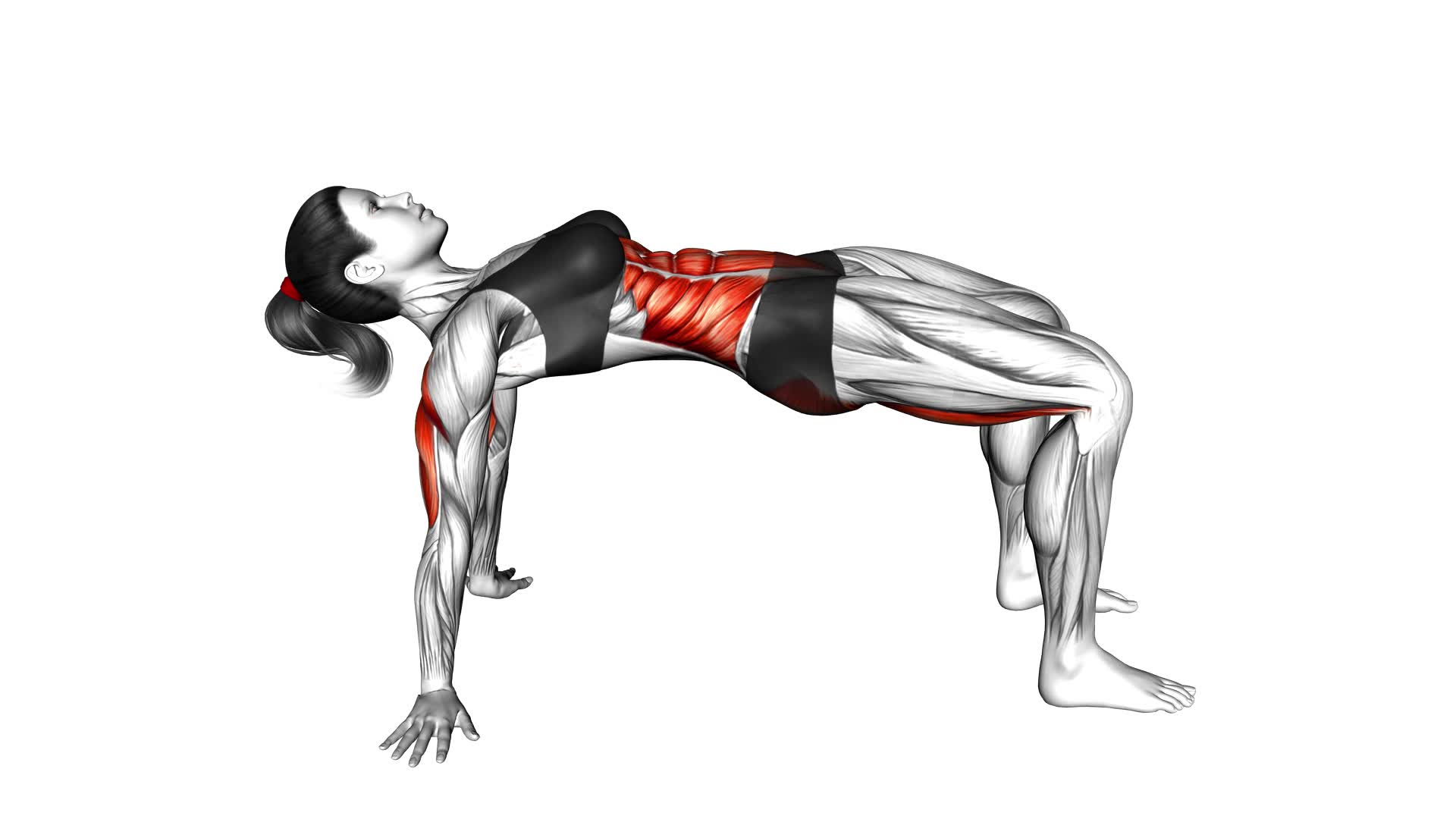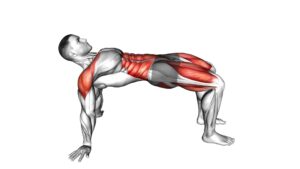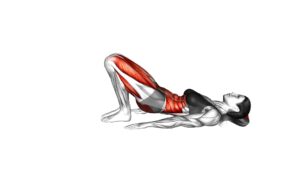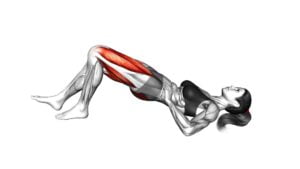Table Top Bridge (female) – Video Exercise Guide & Tips

Get ready to strengthen your core and tone your glutes with the Table Top Bridge exercise.
Watch This Exercise Video
In this video exercise guide, you'll find tips and techniques to help you perform the exercise with proper form and maximize your workout.
Whether you're a beginner or an advanced fitness enthusiast, this guide includes modifications for all fitness levels.
Avoid common mistakes and get the most out of your Table Top Bridge workout with these expert tips.
Let's get started!
Key Takeaways
- Table Top Bridge engages both glutes and core
- Table Top Bridge targets multiple muscle groups
- Table Top Bridge is a great addition to a full body workout routine
- Table Top Bridge enhances performance in other exercises
Benefits of Table Top Bridge
To maximize the effectiveness of your Table Top Bridge exercise, focus on the benefits of engaging both your glutes and core. This exercise targets multiple muscle groups, making it a great addition to your full body workout routine.
There are several variations of Table Top Bridge exercises that you can incorporate into your routine. One variation is the single-leg Table Top Bridge, where you lift one leg off the ground while keeping the other leg bent and your foot flat on the floor. This variation adds an extra challenge to your glutes and core, as you have to stabilize your body with only one leg.
Another variation is the weighted Table Top Bridge, where you hold a dumbbell or kettlebell on your hips as you perform the exercise. This adds resistance and increases the intensity of the exercise, helping to build strength and muscle in your glutes and core.
Incorporating Table Top Bridge into your full body workout routine is beneficial because it engages multiple muscle groups simultaneously. This helps to improve overall strength, stability, and balance. Additionally, the Table Top Bridge can help to enhance your performance in other exercises, such as squats and deadlifts, by strengthening the glutes and core.
Proper Form and Technique
Continue maximizing the benefits of your Table Top Bridge exercise by ensuring proper form and technique.
Proper alignment is crucial to effectively engage the targeted muscles and prevent injury. One common mistake is allowing your knees to splay outwards, which can strain the hips and lower back. To maintain proper alignment, start by positioning yourself on all fours with your hands directly under your shoulders and your knees under your hips. As you lift your hips towards the ceiling, imagine creating a straight line from your knees to your shoulders. Avoid arching your lower back or sinking into your shoulders.
Engage your core and glutes to support your body weight. Another common mistake isn't fully extending your hips at the top of the movement. To ensure proper technique, focus on squeezing your glutes and lifting your hips as high as possible.
Modifications for Different Fitness Levels
As you progress in your fitness journey, it's important to make modifications to the Table Top Bridge exercise to accommodate different fitness levels. There are various progression options available to challenge yourself and continue to improve your strength and stability.
One option is to add resistance by using a resistance band around your thighs or placing a weight on your hips. This will increase the difficulty of the exercise and further engage your glutes and hamstrings.
Another progression is to perform single-leg Table Top Bridges, where you lift one leg off the ground while maintaining a stable position with your other leg. This variation helps to build unilateral strength and stability.
On the other hand, if you have limited mobility or are recovering from an injury, there are adaptations you can make to still benefit from this exercise. One option is to perform a modified Table Top Bridge by placing your feet on a stable surface, such as a bench or step, instead of the ground. This reduces the range of motion and provides more support for your lower body.
Additionally, you can start with a partial range of motion and gradually increase it as you gain strength and mobility. Remember to listen to your body and choose the modifications that feel comfortable and safe for you.
Common Mistakes to Avoid
Avoiding common mistakes is crucial when performing the Table Top Bridge exercise. To ensure that you're getting the most out of this workout and avoiding any potential injuries, it's important to focus on proper technique. Here are some common mistakes to avoid:
- Arching your back too much: One of the most common mistakes is arching your back excessively during the exercise. This can strain your lower back and lead to discomfort or injury. Keep your back in a neutral position to maintain proper alignment.
- Allowing your knees to collapse inward: It's important to keep your knees in line with your hips and ankles throughout the exercise. Allowing your knees to collapse inward can put unnecessary stress on your joints and increase the risk of injury.
- Rushing through the movement: Performing the Table Top Bridge too quickly can compromise your form and decrease the effectiveness of the exercise. Take your time and focus on engaging your glutes and core throughout the movement.
- Neglecting to engage your core: Your core muscles play a key role in supporting your spine during the Table Top Bridge. Failing to engage your core can lead to improper form and potential injuries. Remember to activate your core muscles by drawing your belly button towards your spine.
Tips for Maximizing Your Table Top Bridge Workout
To enhance the effectiveness of your Table Top Bridge workout, incorporate the following tips into your routine.
First, focus on proper form and technique. Make sure your feet are hip-width apart and your knees are bent at a 90-degree angle. Keep your core engaged and your glutes activated throughout the exercise. This will help you maximize the benefits of the Table Top Bridge.
Next, consider adding resistance to your workout. You can use a resistance band or place a weight on your hips to increase the intensity of the exercise. This will challenge your muscles and help you progress in your Table Top Bridge workout.
Another way to maximize your workout is by incorporating variations of the Table Top Bridge exercises. You can try the Single Leg Table Top Bridge, where you lift one leg off the ground while maintaining the bridge position. This will engage your glutes and hamstrings even more. You can also try the Table Top Bridge with a Stability Ball, where you place your feet on a stability ball and lift your hips off the ground. This will challenge your balance and stability.
Frequently Asked Questions
How Many Calories Can You Burn With a Table Top Bridge Workout?
With a table top bridge workout, you can burn a significant amount of calories. The benefits of this exercise go beyond just calorie burn. It also helps strengthen your core, glutes, and hamstrings, improves posture, and increases flexibility.
By engaging multiple muscle groups, you can maximize calorie expenditure and achieve a more efficient workout.
Can Table Top Bridge Help Improve Posture?
Table top bridge variations can indeed help improve your posture. By engaging your core muscles, this exercise strengthens your back, shoulders, and abdominal muscles, which are crucial for maintaining proper posture.
The benefits of table top bridge for core strength are numerous. It not only targets your abs but also activates your glutes and hamstrings. With consistent practice, you can develop a stronger core, leading to better posture and overall body alignment.
Is Table Top Bridge Suitable for People With Lower Back Pain?
Table top bridge is a great exercise for overall fitness. It can help strengthen your core, glutes, and hamstrings.
However, if you have lower back pain, there are modifications you can make to make it more suitable for you. For example, you can try placing a pillow or yoga block under your lower back for support.
This will help reduce the strain on your lower back while still reaping the benefits of the exercise.
How Often Should I Incorporate Table Top Bridge Into My Fitness Routine?
Incorporating table top bridge into your fitness routine can be beneficial for strengthening your core, glutes, and hamstrings.
It's recommended to include this exercise at least two to three times a week to see results.
To add variety, you can try different variations of the table top bridge, such as single-leg bridge or bridge with a stability ball.
Remember to always listen to your body and modify the exercise if you have any lower back pain or discomfort.
What Muscles Does Table Top Bridge Primarily Target?
Table top bridge primarily targets your core muscles. This exercise engages your abdominals, obliques, and lower back muscles. It also activates your glutes and hamstrings.
By incorporating different variations of table top bridge, you can challenge and strengthen your core from different angles. The benefits of table top bridge for core strength include improved stability, posture, and overall functional movement.
Regularly including this exercise in your fitness routine can help you develop a strong and stable core.
Conclusion
In conclusion, the Table Top Bridge exercise is a beneficial workout that targets various muscle groups and improves core strength and stability.
By maintaining proper form and technique, individuals can maximize the effectiveness of this exercise.
Additionally, modifications can be made to cater to different fitness levels, and it's important to avoid common mistakes that can lead to injury.
Incorporating these tips into your Table Top Bridge workout routine will help you achieve optimal results.

Author
Years ago, the spark of my life’s passion ignited in my mind the moment I stepped into the local gym for the first time. The inaugural bead of perspiration, the initial endeavor, the very first surge of endorphins, and a sense of pride that washed over me post-workout marked the beginning of my deep-seated interest in strength sports, fitness, and sports nutrition. This very curiosity blossomed rapidly into a profound fascination, propelling me to earn a Master’s degree in Physical Education from the Academy of Physical Education in Krakow, followed by a Sports Manager diploma from the Jagiellonian University. My journey of growth led me to gain more specialized qualifications, such as being a certified personal trainer with a focus on sports dietetics, a lifeguard, and an instructor for wellness and corrective gymnastics. Theoretical knowledge paired seamlessly with practical experience, reinforcing my belief that the transformation of individuals under my guidance was also a reflection of my personal growth. This belief holds true even today. Each day, I strive to push the boundaries and explore new realms. These realms gently elevate me to greater heights. The unique combination of passion for my field and the continuous quest for growth fuels my drive to break new ground.







